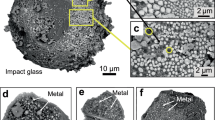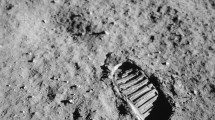Abstract
IT is generally agreed that the glass globules found in type D lunar fines are ejecta from primary meteoric impacts. The impact is presumed to generate melted rock and gas, solidification of the ejecta occurring before they return to the lunar surface, but the precise manner of formation of the globules from the melt is uncertain. In particular, some globules are elongated with rotational symmetry about the major axis1, but retain the smooth surface characteristic of the more common spheroidal globules2.
This is a preview of subscription content, access via your institution
Access options
Subscribe to this journal
Receive 51 print issues and online access
$199.00 per year
only $3.90 per issue
Buy this article
- Purchase on SpringerLink
- Instant access to full article PDF
Prices may be subject to local taxes which are calculated during checkout
Similar content being viewed by others
References
Mueller, G., and Hinsch, G. W., Nature, 228, 254 (1970).
Tolansky, S., Science, 167, 742 (1971).
Isard, J. O., Geochim. Cosmochim. Acta, Suppl. 2, 2003 (1971).
Bastin, J. A., and French, W. J., Proc. Geol. Soc. London, No. 1664, 238 (1970).
Fulchignoni, M., et al., Geochim. Cosmochim. Acta, Suppl. 2, 937 (1971).
Author information
Authors and Affiliations
Rights and permissions
About this article
Cite this article
PUGH, M. Rotation of Lunar Dumbbell-shaped Globules during Formation. Nature 237, 158–159 (1972). https://doi.org/10.1038/237158a0
Received:
Revised:
Issue date:
DOI: https://doi.org/10.1038/237158a0
This article is cited by
-
Rotating lunar globules
Nature (1980)
-
The origin of the shapes of lunar globules
The Moon and the Planets (1979)
-
On the mechanisms of lunar regolith glass particle formation
Nature (1976)
-
Some problems of dynamics of lunar regolith glass particle formation
The Moon (1975)



